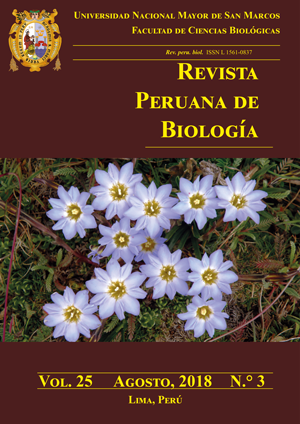Micropropagation and determination of the chromosome number of Puya trianae for conservation and ornamental use
DOI:
https://doi.org/10.15381/rpb.v25i3.15210Keywords:
Bromeliaceae, cytogenetics, diploid, propagation in vitro.Abstract
Puya trianae is characterized for developing a colorful inflorescence, which turned it into an ornamental plant. Is not currently considered threatened, due to the fast habitat deterioration, populations survival is threatened; due to the last, we developed a micropropagation protocol, focused on its conservation and mass production for ornamental purpose, as well as the chromosome counting. For multiplication, seedlings from germinated seeds were used in vitro and we made four tests to determine the type, concentration and time of exposure of some regulators, as well as the partial or total explants excised. Throughout the rooting phase, shoots were grown in MS/2 alone and/or supplemented with IBA and NAA; the acclimatization of the obtained seedlings was carried out in different mixtures land:peat:capote, in a growth room and a greenhouse. Buds and shoots that finished their development during 45 days in MS+2.0 mgL-1 of TDZ were the majority, after three months of development. The shoots rooted in MS/2 quantifying a 70% of rooting. A 90% viability and a plantlets length of 3.6 cm in soil: peat after 60 days of transfer. We made a radical meristematic cells chromosomal counting treated with a 0.5% of colchicine fixed in carnoy, hydrolyzed with HCL and enzymes and stained with acetic orcein, obtaining a chromosome number of 2n=50, with very small chromosomes (aprox. 1.2μm).Downloads
Downloads
Published
Issue
Section
License
Copyright (c) 2018 Jennifer Andrea Castro, Eyda Johanna Araque, José Estiben Pacheco, José Constantino Pacheco

This work is licensed under a Creative Commons Attribution-NonCommercial-ShareAlike 4.0 International License.
AUTHORS RETAIN THEIR RIGHTS:
a. Authors retain their trade mark rights and patent, and also on any process or procedure described in the article.
b. Authors retain their right to share, copy, distribute, perform and publicly communicate their article (eg, to place their article in an institutional repository or publish it in a book), with an acknowledgment of its initial publication in the Revista Peruana de Biologia.
c. Authors retain theirs right to make a subsequent publication of their work, to use the article or any part thereof (eg a compilation of his papers, lecture notes, thesis, or a book), always indicating its initial publication in the Revista Peruana de Biologia (the originator of the work, journal, volume, number and date).






